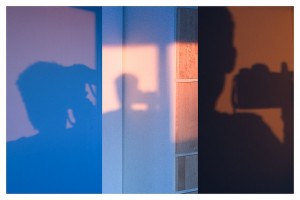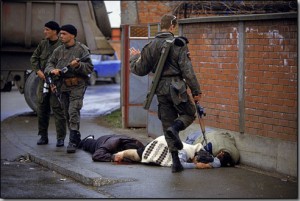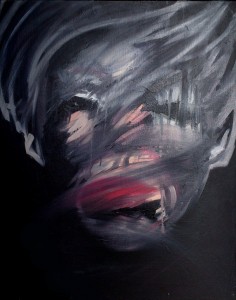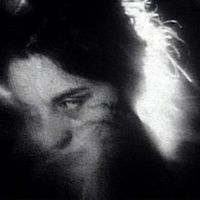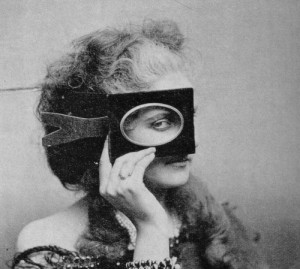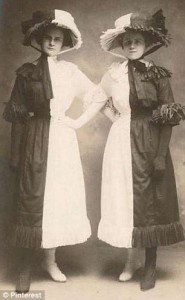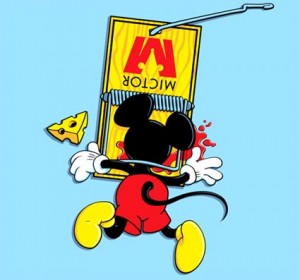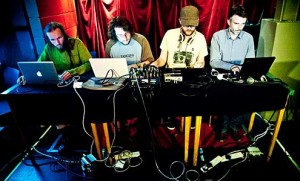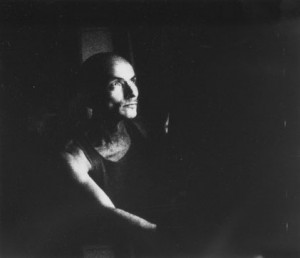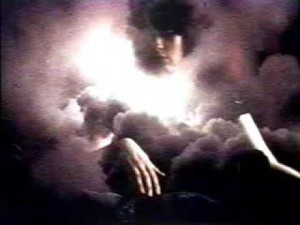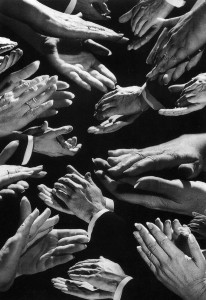
Owen: You use a lot of found footage in your work. I get the sense from several of your videos (most notably Imitations of Life (2003) and Amy (2005) that the choice serves as a deliberate critique of the potential violence of image-making. Amy, the final section of Public Lighting (2005), really brings this point home for me, implicating us, as an audience, in the dehumanizing processes of representation. Do you consider representational image-making to be inherently violent? Does this question play into your work? And is your use of found footage not simply an effort to reclaim the detritus of mainstream representations, but also a means by which to avoid the violence of image-making?
Mike: Godard says about watching movies: “How wonderful to be able to watch what you’re unable to see.” When I was growing up, my parents made pictures of me, at first in small black and white squares with serrated borders, and then, after my brother was born, in colour. Making a portrait was an activity once reserved for queens and emperors, but democracy has ensured that this aristocratic privilege has now become a restless doubling of everything around us. Because my memory is poor, the pictures my parents made have taken the place of my childhood. Is this violence? It’s certainly not the same as looking up into the sky and watching Agent Orange drop, which is how Vietnamese kids my age were greeting their mornings. Many of them would die terrible deaths courtesy of Dow Chemical and Monsanto and dozens of other chemical companies which are still operating today. Isn’t the failure to make a picture of these children, and the inability to make clear how their suffering is attached to production of a “weapon of mass destruction” here in North America, a form of violence? No, I don’t believe that making a picture of a tree, or a face, or the way light falls on a striped awning, is inherently and necessarily violent. Though each of these pictures could be used that way. I think your question is about the subject position of the picture taker: who am I when I am behind my camera shield? Is everything that I do in that place a form of violence?
I’ve never owned a still camera, perhaps because making pictures is something I associate with work, perhaps because I simply wouldn’t know what to do with the results. How to organize all those snapshot moments, all that unwanted, unlooked-at stuff? But I do make sentimental pictures, particularly of my nephew Jack, though these pictures arrive vicariously, like so many forms of masculine affection. For the past year I have been trying to make a videotape about my friend Mark who died suddenly and unexpectedly in the spring of 2007. He grew up in the same area of Burlington that I did, and Jack lives close by. I have visited with Mark’s family and friends, slowly gathering pictures of remembrance, because Mark’s not around to speak for himself. It’s hard for me not to see Jack as some younger version of my lost friend, and when I drag him out to the park (where he shows me how he can set himself on fire), or ask him to revisit our old high school, the pictures are at once past and present, memorials for someone Jack will never know, and part of our own, ongoing, shared histories. Making pictures is something we have in common, ever since my sister decided that casual snaps and home movie stylings were the mawkish issue of those concerned with the preservation of something forever lost – their own childhood perhaps, or even their own idea of childhood. My sister was concerned with the present, an attitude I greatly respect. In the absence of these throwaway charms, I began making home movies with a clumsy, wind-up, 16mm camera when Jack was in his high chair, and continued until the age of seven or eight when he appeared a bit too self conscious to continue. Please don’t point that thing at me anymore, when you do I feel beside myself.
I wouldn’t shoot more than a roll of film per year, maybe two or three minutes in all, so he’s not yet shrinking from overexposure. There was a lapse of many years, and now, nearly seven years later, I have asked him to join me in this project, which is a portrait of my once home, my almost childhood, and a look at Jack himself who is no longer a pablum eating crawler, but a teenager busy designing my website when he’s not scoring goals for his double A hockey team. The pictures we are making are not violent, though they are the issue of Mark’s violence, which he turned fatally towards himself. The pictures of Jack come out of a complicated familial pattern of trust and hope and love, and out of the need to leave a trace for Mark where he failed to leave one. Mark was someone who lived always in the background, forever helping others, pitching in, lending support. How does one make a picture of the background? There are many possible solutions, but the one closest at hand was to ask Jack. Now that some of my friends have kids, I am learning, again and again, that they know much more than we know, and that it is important to consult them, to look up to them, to follow their lead.
“When it’s time to close the book, I’ll have no regrets. I’ve seen so many people live so badly, and so many die so well.” (Je Vous Salue, Sarajevo by Jean Luc Godard)
In Amy there are three photographs on view, each featuring the titled subject. They appear in reverse chronology, in the third picture she is younger than in the first. What do they show? One features a girl-woman wrapped in a large towel. There is a shallow depth of field, but within that field everything is razor sharp, every detail crisp and clear, every nub of the towel and whisper of slicked back hair is visible. These details make clear that this is not a casual snapshot, it was made with a large format camera capable of exposing 8X10 negatives. In other words, it’s not just between the two of us. The others have gone away so that we can have this moment together, you and me and my three-legged friend. And judging by those sandy footfalls the others haven’t been away long. But for this moment you, the other, the girl who is not yet a woman but no longer a girl, stand there like the last person on earth, looking back at the camera.
There is something about the look on her face, the way she looks. It’s as if she sees past the camera, past even the eyes that are busy framing and focusing her inside the upright rectangle. It’s as if she knows what those eyes want, what is ‘behind’ those eyes, the eyes of the looker. Is it because her left eye is slightly raised while her right drifts ever so slightly to the right? Her eyes make clear what her body is still too young to know. This is part of what gives this photograph its great tension. Her eyes are speaking directly to him, the first viewer, and then beyond him all the other viewers, the ones who are waiting inside the egg of his eye, waiting to be summoned. Her eyes are telling him that she knows what he wants.
It has to do with her surface, the way her parts are arranged and composed, deployed even, across the surface of her skin. Her body. It used to be her body, but now she knows what he wants, or rather, she is remembering what he wants, because of all the other women on all the other beaches. Her mother’s mother’s mother’s mother. She knows what he wants because it’s what he’s always wanted, all this time. And he’s still here wanting it, wanting her. The towel she wears does not protect her from this look. The truth is, for women like her (for women condemned to remember), there is no protection. The look on her face says: the violence has already occurred. What is this violence? I think it is the violence of looking, memorialized, celebrated even, in pictures like this one. This is a picture which shows how a man looks at a woman. And by looking at her, and making a picture, he makes her look at herself. “Oh, is that how you see me?” becomes, too quickly enough: “Oh, is that how I am?” That’s why the face is so hard and nearly furrowed, nearly confrontational. She is being presented with her own face and her own body, but seen through his eyes, and the violence comes because she has come to recognize his view as her own. Oh yes, it’s me, it’s always been me.
The photograph is a gift, it makes an object out of his look, and an object of what is being looked at. Like most gifts, it is unwanted. The towel offers her the illusion of reprieve, a temporary escape, but when we see her without it in a second picture, there is no real difference. Both pictures are equally naked and raw, even in their stately, classical compositions, because of the knowing already contained in her face. If there is tragedy in her teenaged face it is because she understands that her body doesn’t belong to her anymore. The pictures are a threshold that mark the place between girl and woman, they are not only evidence, they are somehow the thing itself, the primal scene at last made visible. Here is the moment of turning, when she came to see herself as he saw her. As a sexual and desiring subject. How cruel and difficult and complicated is this violence of looking, summarized in a photographic instant on this Montalivet beach.
These are very well known pictures, in part because the shot of the girl-woman in the towel is the cover of The Last Day of Summer, a book of photographs by American photographer Jock Sturges. In his afterward he writes “Often I photograph people who are at an age at which, in my own life, I was least happy. Time and again my few good friends would disappear from the schools and summer camps I attended, swept away by time, by the end of terms and semesters, by the end of summer. And very often I’d never see them again.” The threshold between girl and woman is also the change from summer into fall, from languorous afternoons at the beach to the business of school. Sturges writes about the disappearance of his friends as if he’s still waiting for their return, still holding onto the last day of summer as long as he can, even as a picture. But the truth is, he was never there, no one was ever there. And his camera is used not in order to leave a mark which could grieve this passing, but to remove and disappear. Amy’s family has disappeared. Along with her clothes, her towel, the background of the beach. What is left is a shimmering aura of surfaces, a utopian aesthetics of “perfect” bodies in nature, and a look which belongs to the camera, only now it has resettled itself onto the face of this young, not-quite-woman.
Here is author William Gibson talking about the first film he ever saw. “I remember being taken to my first film, either a Disney animation or a Disney nature documentary (I can’t recall which I saw first) and being overwhelmed by the steep, yet almost instantaneous, learning curve. In that hour, I learned to watch film. I was taught, in effect, by the film itself. I was years away from being able to read my first novel, and would need a lot of pedagogy to do that. But film itself taught me, in the dark, to view it. I remember it as a sort of violence done to me, as full of terror as it was of delight. But when I emerged from that theater, I knew how to watch film.” (A talk given at the Directors Guild of America’s Digital Day, Los Angeles, May 17, 2003)
I think Amy would recognize the experience that Gibson describes here. He is learning how to see a movie, but in order to do so, something in him has to change. He experiences this change as violence. In order to learn how to see herself as Jock Sturges does, Amy has to change something inside herself. I believe that, like Gibson, she experienced this change as violence, and that it is exactly this change and violence that can be read on her face. It makes her face look so much older than she really is, and underscores the division between her body and the way her body is looked at.
Owen: Your points about the potential violence of image-making are well taken. Certainly this violence originates more with the use of images than with their actual production; but I also agree that production and use are often intimately connected, as your Gibson quote points out in relation to Amy. It seems that the production of Jock Sturges’ images was a form of violence because Amy knew how those images would be used. I’d like to return to what Gibson had to say. The idea of the film medium teaching us how to read it is somehow alarming and violent. In your work you resist conventions of spectatorship, and I’d like to discuss that in relation to your uses of found footage. In your experience, how can found footage disrupt the processes of classical spectatorship and liberate new meanings in the relationship between the audience and the material on screen (and/or the artist)? I’m thinking specifically of pieces like Stormy Weather, with its (relatively) conventional narrative coupled with parallel found footage inserts; Positiv, with its four split screens; and Tom, in which found footage seems to furnish much of Tom’s memory and world with images.
Mike: Have you ever been to a laptop concert? It is a relatively recent occurrence, no more than a couple of decades old, and one which has found a strange currency in fringe portals. There are usually no instruments involved, though occasionally a guitar or some more exotic item might be plucked, or bowed or dropped just once on the ground. The sounds produced are often drawn from “found” sources, from the radio for instance, or instrumental samples from already existing musics, or field recordings. These are then bent and layered and filtered and re-shaped to produce a heavenly and abstract sound. These musicians are working with the same computers, in the same digital realm, and occasionally presenting in the same venues, as their motion picture cousins. These anti-concerts typically feature the artist squatting behind a laptop and mixer, tweaking sliders. They don’t hold their instruments above their heads in triumphal posings, some refuse even to stand in front of the audience at all. There are no stage costumes or lighting changes and some leave before the music stops. No one bows or waves, talking of any kind is rare, even introductions are not usual. There is a very deliberate anti-theatricality going on, not larger than life stagecraft, but smaller than life. It breaks down the traditional hierarchy of presenter and audience, instead they/we quietly celebrate a slacker emo democracy, which arrives out of a post-punk, DIY aesthetic. No more heroes, no more monuments, no more great leaders. Instead: there’s work to be done, and we’re all in this together. If many perform under different names it is because naming, making a name for yourself, the narrative of the lonely hero artist, is another ideology which is being left behind.
Positiv is a ten minute short which provides an opening to Panic Bodies (70 minutes 1998). PB was the last film I made in 16mm, though Positiv was made on video, then transferred to film, so it marks the transition. It is a kind of autobiography, or at least it appears autobiographical, with the author speaking in one of the four small frames that offer a simultaneity of pictures. He dishes a text on being HIV-positive, and how this has changed relations with family and friends. This movie was made several years before the advent of the cocktail, in a moment when many were dying because there simply was no available treatment. Susan Sontag, no stranger to illness herself, wrote of illness as another country. Part of the point of this movie was trying to get people to come over to this country and have a look, to ease some of the stigmas and fears that were attached to being positive. The three screens which do not show the speaker are stuffed with found footage moments, along with some home movies, science films and Hollywood star turns. Again and again they offer pictures of the body in distress; melting, freezing, shattering, broken. How often have we imagined our body—the collective body we gather into and become as we sit in the cinema—gazing up into hands that are a block long? These bodies are introduced to allow a drifting counterpoint to the personal narrative which arrives in the words of the narrator.
Because the presentation is simultaneous, with three screens rapidly pushing out pictures, there is no way to “follow” them. Instead, viewers are asked to make a choice, seeing one screen means refusing another, and in this way, as one choice follows another, each viewer creates their own movie. The point of this fragmentation was to mimic the effect of the illness inside the body, and the hope was that this fragmentation might be extended to the movie theatre, where each viewer could find their own way towards their own body. I am thinking of this moment from Nicole Krauss’ perfect novel, The History of Love: “I like to sit up front, I like for the screen to fill my whole view so that there is nothing to distract me from the moment. And then I want the moment to last forever. I can’t tell you how happy it makes me to watch it up there, blown up. I would say larger than life, but I’ve never understood that expression. What is larger than life? To sit in the front row and look up at a beautiful girl’s face two stories high and have the vibrations of her voice massaging your legs is to be reminded of the size of life. So I sit in the font row. If I leave with a crick in my neck and a fading hard-on it was a good seat. I’m not a dirty old man. I’m a man who wanted to be as large as life.”
Tom (2002) is related to the too-much presentation stylings of Positiv. From the movie’s beginning, which offers a flood that engulfs the island of Manhattan, there is a restless flow of pictures, rapidly edited, which offer fragments of the motion picture history of one of the most photographed cities of the world. Once again, it is impossible for any viewer to recall each picture, each sequence, so as the images rush on past, the hope is that each person will find moments that resonate with their own lives.
So much of what is on Tom‘s display screen are moments from a “common” motion picture heritage, excisions from movies past which some in the audience will have already seen. These, in turn, carry their own associations (my first kiss, the last movie I saw in the city I was born in), and these paralleling narratives, far from being unwanted, are embraced, even encouraged, via the use of found footage. Introducing the foreign agent of another frame inside the frame that you are building means that a complex of associations and relations are also introduced, and there is no real way that any artist can track down each and every one of them. Your work has become impure, and carries with it, and away from it, thoughts which seem foreign and extraneous. In place of the idea of the work as an autonomous creation, it becomes a staging site for individual viewer fantasies and informations.
Why is this important? Doesn’t it seem counter-intuitive, or simply contrary, to work against the notion that cinema offers because of its fundamental structuring rhythm: the assembling of a common cause, a united audience? Or in the case of broadcast: the simultaneous transmission and reception of a signal. To create work which aims to upset the consensual agreement implicit in a gathered crowd seems, at first glance, to be contrary to the very idea of what cinema is all about. Haven’t we come together in order to look together, to face the same pictures in the same way?
Well, perhaps no. Let’s look at what Freud had to say about this. He argues that the Copernican Revolution showed that the earth is no longer the centre of the universe. In the nineteenth century, Charles Darwin proposed that human life shared its origins with other kinds of life. And then in the 20th century, Freud showed how consciousness is driven by events we have no awareness of. When Freud was writing, there was an increasing pressure on the human subject, on the coherence of the “I.” Cinema was introduced at that same moment as a social instrument to bolster a failing subjectivity, and in an economic sense, to provide some necessary distraction and pressure release for working class hopes. Cinema brings “us” back together, at the same time as it creates “larger than life” heroes and heroines who can play out again the old narratives of subjectivity, breathing new life into them. What a paradox! “We” are unified at exactly the moment that our subjectivity (our unique sense of self) is being born. Capitalism wouldn’t have it any other way.
Make no mistake: working on the fringe is a poor way to wage the class war. Nonetheless. In this moment of increasing globalization, which means mostly turning everything and everyone into a market, into consumers wanting to buy their way into a better life, fringe movies represents a quiet naysaying. They fail to provide the necessary audience cohesion to allow for that grand recit thrill, the shared feeling of relief, even delirious joy that two screen lovers (Why always two? Why not five or eight?) have at last found each other. In the fringe there are many tactics to avoid the massing of these impulses, and the use of found footage is one of them. In a fringe audience, when it’s working at least, everyone is off having their own feelings. It is not a place of escape, but of encounter. The most important movies are not onscreen, but in the minds of the viewers, who are not passively receiving, but actively creating their own movie alongside the one that is being shown. In this sense, the movie on display is always a “found image,” while the real show remains, privately and largely unseen, inside.

